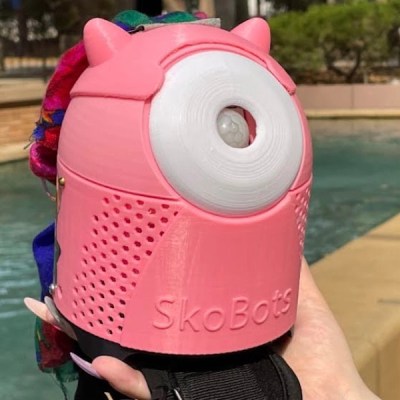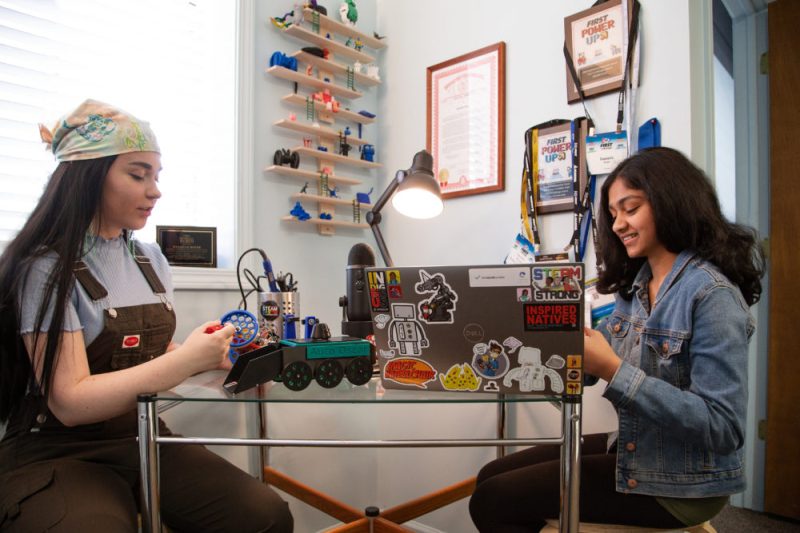[Danielle Boyer] is Ojibwe: Sault Ste Marie Tribe and passionate about preserving vanishing indigenous languages. She’s invented a shoulder-worn talking companion, called a SkoBot, to teach STEAM to children through building robots programmed with indigenous language lessons and founded the STEAM Connection to give them away.
 Through her Every Kid Gets a Robot program, more than 8,000 ESP32-based kits have been distributed to students. With a total cost of less than $20 USD, the 3D printed bots help democratize access to robotics. As many rural areas lack access to high-speed internet, they are designed to be controlled locally by the student’s phone.
Through her Every Kid Gets a Robot program, more than 8,000 ESP32-based kits have been distributed to students. With a total cost of less than $20 USD, the 3D printed bots help democratize access to robotics. As many rural areas lack access to high-speed internet, they are designed to be controlled locally by the student’s phone.
During an interview on WBUR in Boston, [Danielle] recalled that one of her students once said that she was the first Native person they’d seen in robotics, and she inspired them to get into it. “That really made me emotional and inspired to see the power that us being ourselves has and being authentic to ourselves, to our community, I just think that’s such a beautiful thing.”
Learn more about the impactful and fun work [Danielle] is doing at the STEAM Connection that scored her an invite to the White House, see a preview in the GMA video after the break, and watch for her plant-based BioBotz coming later this year.
This isn’t the first time we’ve seen robots invade the classroom: from student-built “Battle Bots” to the modular 3D printed SimpleSumo project, these educational initiatives can help teach the basics of electronics and software development in a more engaging way than simply reading theory from a textbook.
















For some unknown reason, I am craving the delicious, satisfying beverage Slurm…
Do you want a Bender the Offender official hat?
Ojibwe, south central Canada?
Yes and north central midwest U.S. Where I’m from it was (corrupted) to “chippewa”
…by the big lake they call Gitche Gumee…
Is there any info on the robot kits themselves? If her organization is just giving them to schools anyway, why not make it open source?
The kits and resources they are supplying are private and recipients are required to agree to keep them so. I expect that’s to prevent opportunists/scammers from taking it and pretending to be affiliated with the charity.
They do have an open source robot called Twenty on the site, though.
Love the cuteness! I’m getting Ghibli vibes.
The problem with STEM is that the M should come first, so MSET makes more sense. Add some art in there and everyone is happy MSETA. It costs almost nothing, in material terms, to learn a lot of mathematics and that really is where kids need to start. Having tried that if they didn’t get anywhere then they need to be honest with themselves about how far they can get with the SET part. I do not value the idea of wasting a child’s time on things that they just don’t have an interest and aptitude for, it is far better to discover what is unique about them and nurture that fully.
Yeah, but math doesn’t market well as a lead in. Got to catch their attention with the flashy stuff first. The math comes along naturally, as the others all require it. Even the art, although much more abstractly. When I was a kid, my mind didn’t process math the way the education system wanted it to. The wrote, and repetition, and formulas could not stick. My mind broke large numbers into decimal orders, and processed them in a sort of parallel, columnar fashion, and I never had a proper method of showing my work, which aggravated teachers no end. Even though my answers were correct, they did not have evidence of what they had taught me, which apparently was nothing. This always led to an unpleasantness when it came to math classes.
Algebra was the most ridiculously pointless course I had to endure, with no foreseeable use, until later on when I was introduced to computers and Basic programming. Then, it became natural and essential. Engineering brought in all the other maths. To this day, though, I still couldn’t jot down a formal equation to explain something if you paid me.
It’s STEM/STEAM because of the acronym, not because it’s any sort of “listed in order of importance”. You can critique a particular implementation, but pointing at the acronym is silly.
Also, forcing kids to learn a bunch of maths before they can get to the “fun” stuff is the best way to ensure the kids hate math and don’t continue. Often letting people play with the hands on stuff without worrying about the underlying details is what motivates them to dig deeper themselves.
What amazing work! I’d love one of these to try out while we conduct a pilot study within our tribe. We are on the path of preserving our Acjachemen language.